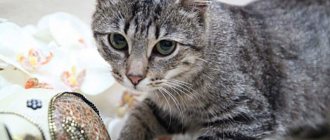Genetics of white color
The beautiful white color of cat fur is unique primarily in that it is not formed due to a coloring pigment, like all other colors, but, on the contrary, due to the lack of pigmentation. The genetics of this color are especially interesting in blue-eyed “blondes”.
White blue-eyed cats have special genetics
The blue color of the iris is a manifestation of the dominant gene for white color, which is usually denoted by the Latin letter W. This magnificent eye color is called royal, and its gradation varies from very light blue to deep sapphire.
But the main “insidiousness” of the W gene is that, along with hair pigmentation, it blocks the growth of hearing aid cells in the developing embryo. This is why many white cats with blue eyes are born deaf. This pathology is most common in outbred animals, because during breeding work inside nurseries, breeders conduct strict selection and do not allow animals with hearing loss to be bred.
The spectacular bright appearance of the white blue-eyed girl simply cannot help but attract attention. White cats, after black and tricolor, lead in the number of myths and superstitions of which they are the heroines.
People have always paid attention to white cats
The ancient Egyptians, who are most often called the first domesticators of cats, considered the birth of a white kitten to be a gift from the gods and highly revered this white and fluffy miracle. In various European countries, the blue-eyed white cat was often perceived as the earthly incarnation of a guardian angel. The house in which such an animal settled was under its protection from evil forces and vicissitudes of fate.
These cats are often endowed with mystical properties
Breeds of white cats with blue eyes
The standards of many domestic breeds allow white cats in combination with blue eyes. Eyes can also be yellow, green or multi-colored - this interesting phenomenon is called heterochromia.
Turkish Angora
This most famous of white cats is distinguished by its beauty and extraordinary harmony - despite the fact that the Angora's famous ostrich-feather tail is considered the longest of all domestic cat breeds. A centuries-old selection strategy has made it possible to create a wonderful animal, perfect both in appearance and in character. The Turkish Angora is famous for its high intelligence, friendliness and excellent adaptability.
For the beauty of the Angora, white is the preferred color
Although the modern breed standard declares a wide variety of colors, white was and remains the preferred one of all of them. Not only Angora cats can be white and blue-eyed, but also other traditional Turkish breeds: Anatolian cats and Turkish Vans.
Video: white color - Angora classic
British cat
A separate requirement of the breed standard for a white British cat is purity of color - no nuances, not a single non-white hair! On the special, plush fur of British women, the white color looks unrealistically beautiful - especially in combination with bright blue eyes. It is no coincidence that the white shorthaired British cat named Koby was recognized as the cat with the most beautiful eyes in the world.
“Plush” white coats are very suitable for British cats
Kobe lives in America, in Baltimore. He was born in 2015, and since childhood he has had his own Instagram page and more than 250 thousand subscribers! Koby's owner, young designer Rebecca Shefkind, is periodically tried to be caught using Photoshop - well, a non-cartoon cat can't really have such eyes?! That’s why Rebecca posts not only photos but also videos of her pet with enviable frequency: no Photoshop!
The most “big-eyed” cat in the world is named Koby
Video: meet the same Kobe
https://youtube.com/watch?v=sjTIOmzKqtk
Siberian breed
Pure white color is rarely characteristic of Siberian cats - usually there are some shades or markings in their rich fur coat. But such an exclusive color does not in any way affect the character and behavior of this strong, charismatic animal.
White Siberian cats are a rarity in the breed
Considering the history of the origin of the Siberian breed, it is quite strange that the appearance of pure white kittens in it is such a rarity. After all, a white cat looks more than natural in the snowy expanses of Siberia. And very impressive.
White cat on white snow looks amazing
Cornish Rex
The unique coat of curls and curls makes this breed one of the cutest pets. But the Cornish Rex is attractive not only for its funny appearance, but also for its sweet character - cheerful and friendly.
Cornish Rex - blue-eyed "sheep" cat
The breed is considered hypoallergenic, but white Cornish dogs themselves are quite often susceptible to allergies. Owners of such charming animals need to remember this.
Persian breed
The flattened muzzle of a Persian, only at first glance, may seem to be always dissatisfied with something - but in fact, they are very affectionate and grateful animals. The breed's phlegmatic nature in the case of a white color is only a plus, because such a wonderful fluffy coat needs to be carefully protected, and not wiped off the dust under the sofas with it during endless games and hide-and-seek.
A white Persian is always a bright personality, and not only in appearance
The only problem is that purebred white kittens are a rarity in the Persian breed. Such individuals are especially highly valued, and often the breeders do not agree to part with such beauty for any money and leave the white animals at the nursery.
Scottish breed
A cute, unusual appearance is not the only advantage of the Scottish cat - this charming creature has a unique ability to compromise. Scottish is able to “agree” and make friends with anyone, and at the same time - set the whole family on a peaceful and prosperous wave.
Scottish fold kitten is cute and touching, like a little child
Since pure white Scots are still very rare, and the demand for them is very high, the cost of such a miracle kitten is impressive - it can sell for double or even triple the price of its littermates.
Russian white cat
Oddly enough for a breed with such a name, its history began in... Australia, from the Russian breeds brought there: a white Siberian and a blue cat. The result of such a remote-Russian experiment was the appearance of this young breed, which few people know about yet. The descendants took after their father, a Russian Blue, in coat quality, and their mother, a Siberian cat, in color and disposition.
The Russian white cat was invented in Australia
They are self-sufficient, not capricious, have a strong nervous system and enviable health. Australians, to whose green continent it is so problematic to import new pets, have managed to fall in love with snow-white cats of their own breeding with a purely Russian name.
But felinological organizations do not yet have a common opinion about the young breed. The ACF and GCCF consider it a variation of the Russian Blue, and the ACFA proposes to combine all Russian Shorthair cats - blue, white and black - into a single breed. The Russian White received full recognition only in the RAS (Royal Agricultural Society) Cat Fanciers Club - this happened in 1975 in South Wales.
Sphinxes
How can a hairless cat be white? Not only can it, but it happens often, and what’s more, it is extremely popular. Look at the Sphynxes (Canadian, Don, and St. Petersburg) - these hairless cats have a wide range of colors in their breed standards, but white is beyond any competition!
The white sphinx with blue eyes is fantastically beautiful
The Sphynx's special attraction to humans, incomparable with other cat breeds, makes communication with them unique and very touching. The unique property of the breed, which is highly human-oriented, allows Sphynx dogs to be used in many types of zootherapy.
Oriental
The colors of the Oriental cat breed could be the topic of a separate story with a very exciting plot. For many decades, felinologists around the world have had heated debates on this issue. About a hundred years ago, the elite British Club categorically refused to breed any colors other than the Himalayan. Since then, and for a very long time, the predecessors of modern Orientals were severely limited - both in population and in development.
The white color of Orientals has only recently been officially recognized
Only in the late seventies of the last century did enthusiasts manage to achieve recognition of solid colors, including white. And in 1995, the modern standard for the Oriental breed was finally approved.
All Orientals are extremely inquisitive and more talkative than most other cats. They probably just want to share their observations with others - this is really very interesting.
Foreign white
“Foreign White” is the somewhat unusual translation of the name of the Foreign White breed . This is still an experimental breed, not recognized by all felinological organizations, which is essentially a Siamese cat of a white monochromatic color. Therefore, the authoritative association TICA, which recognizes the Foreign White, proposes a unified standard for the Siamese group of cats, to which it also includes the “foreign white” breed.
The cat is very graceful and elegant, agile and willful, it is distinguished by high intelligence, good learning ability and strong affection for humans. From their ancestor breeds - the British White Shorthair and the Seal Point Siamese - Foreign Whites have inherited the best qualities that are highly valued by their owners. Despite the fact that these cats are only white and only blue-eyed, their offspring are born with good hearing and do not show signs of albinism.
Representatives of the Foreign White breed can only have bright blue eyes, without options. And this is their main difference from all other purebred white cats. The idea of creating snow-white and blue-eyed cats of the eastern type, not burdened by hereditary deafness, belonged to the famous English geneticist Patricia Turner, who began work on a new breed more than half a century ago.
Foreign white literally translates to “foreign white”
Kao-mani cat
These cheerful and friendly cats belong to an ancient aboriginal breed originally from Thailand, where only those of royal descent had the right to keep them. The first written mention of the breed appeared in the fourteenth century. Now the attitude towards the breed has become much more democratic, but it still remains rare and accordingly costs a lot - it is among the top 10 most expensive cats in the world.
Kao-mani are still endowed with mystical glory to this day - they are believed to bring good luck to their owners, and the eyes of these cats have special magical powers. Initially, the eyes of the kao-mani were exclusively blue, but now other color options have become possible. But the special, seemingly faceted shape of the eye lens remains the same, which makes the cat’s gaze truly magical.
No other cat has such amazing eyes - only Kao-mani
Despite the developed hunting instinct, Kao-mani are absolutely devoid of aggression. They are extremely playful and active. They do not like to be left alone and feel best in the company of a large cat. Be prepared for the fact that these Thai snow whites are talkative, sometimes even too talkative.
Video: Sacred and Special Kao-Mani Cats
Myths about white cats
Humanity is favorable to felines. In all centuries, people have treated black cats with special reverence. They became heroes of myths, fairy tales, and were even endowed with magical powers. However, not only the coal beauties were destined to gain fame, but also their complete opposites - snow cats, who also have their own entertaining stories.
Myth No. 1. Deafness
Rumors about the deafness of snow-white cats are not groundless. And geneticists themselves are in no hurry to debunk this myth. The fact is that cases of hearing pathologies among colorless cats are quite common.
White cats can also inherit deafness from parents of different colors.
The reason for this is the W gene, already familiar to us from the previous chapter. In addition to snow-white fur and blue eyes, this element of the genetic chain leads to congenital deafness. In 40% of cases, pets with this genotype are born with complete deafness.
A prerequisite for the birth of a deaf kitten is the presence of the W gene in one of its parents. In this case, the mother and father will not necessarily be white. Even red and black cats can give birth to heirs with hearing pathologies.
Despite the widespread myth about deafness, this disease affects only 15% of white cats
However, those who want to buy a white pet should not give up this idea. Since most colorless cats in the world are albino, not related to the W gene, the likelihood of purchasing a deaf kitten is quite low. According to statistics, only 15% of all white felines in the world cannot hear.
For those who want to take home a kitten with a white coat, there are several rules for testing the pet’s hearing:
- Listen to the sounds the kitten makes. Kittens with hearing impairments meow much louder than their peers. This is due to the fact that the cub does not hear its own voice, so it tries to “shout out” to those around it.
- Normally, a kitten should respond quickly to extraneous sounds. Loud claps should certainly alert him. To check this quality, it is enough to clap your hands when the kitten does not see the inspector.
- The kitten's ears should be clean and not cause concern to the baby. The cause of pathologies can be not only a birth defect, but also infectious diseases.
- Deaf kittens flinch from unexpected touches. You can check this by approaching the pet from the back.
- A deaf kitten is easy to guess by its isolation. He will often ignore his brothers and not take part in their games.
The stereotype regarding deafness will also help to debunk some breeds whose white coat is considered a sign of aristocratic blood, and not a defect. For example, the Turkish Angora, whose wool has become a real symbol of the breed.
There is a legend that the rulers used the wool of the snow-white angora as a napkin.
Those who have taken custody of a deaf kitten should not rush to get upset. The baby will require more attention and your strength, but his gratitude for the care you show will be much greater.
Myth No. 2. Eyes of different colors
Different colors of the iris are not such a rare phenomenon. The so-called heterochromia occurs not only in felines, but also in other animals. The phenomenon of heterochromia also affected humans. It is curious that scientists have not yet identified the exact cause of such an unusual effect.
Heterochromia in a dog and its owner
Possible causes of heterochromia in animals:
- uneven distribution of melanin, the pigment responsible for the color of the coat and iris of the eye;
- the same W gene in DNA, passed on from generation to generation;
- predisposition to diseases.
Heterochromia is not a breed specific trait. Any random cat can inherit eyes of different colors. Combinations of shades also vary: the most common tandem is yellow and blue. You can also find combinations of golden, green and brown colors.
The monopoly on eyes of different shades does not belong to white cats.
Among white cats, the anomaly of different eyes is much more common than among its red and tortoiseshell counterparts. Most often, heterochromia comes along with hearing problems, which is caused by the same “white” W gene.
Sphinx with a rare combination of green and blue eyes
Considering the breeds, geneticists have identified the three most often inheriting multi-colored irises:
- Turkish van. Most cats of this breed are white, which in itself increases the likelihood of congenital deafness and heterochromia.
- Turkish Angora. A favorite of the Shahs, the history of this breed dates back to the 16th century. The most common eye colors in these cats are blue and yellow.
- Kao-mani . In representatives of the breed, the iris may be spotted, interspersed with other patterns.
Spotted heterochromia in kao-mani
Other breeds are less susceptible to heterochromia. Multi-colored irises are found in the British breed, Orientals, Sphynxes and Rexes.
Myth No. 3. Unconditional charm
The most poetic myth claims that every snow-white cat is an angel in the flesh. However, the owners of such pets refute the misconception. Coat color does not in any way affect the habits of the animal. The behavior model is formed according to different principles. The first and main violin is played by genetics - the pedigree of the animal.
Each white cat is individual and has its own set of habits and behavioral characteristics.
Descendants of native breeds are sure to inherit predatory genes. Even at home, when food flows like a river and the sky is cloudless, the cat continues to hunt for everything that moves. This is how the wild roots of all felines manifest themselves. The color of an animal's coat does not play any role in determining its character. Both a gray and a white cat can become an excellent mousetrap.
No matter what color the cat is in front of you, remember that you are dealing with a predator.
The thirst to hunt is also reflected in the animal’s relationship with its owners. Of course, the cat will not try to catch the owner, but he will definitely try to establish his own rules at home. In the apartment where a pet lives, a special hierarchy reigns: everyone’s pet can be petted only at his request, and the interior sometimes undergoes multiple corrections with the help of the cat’s claws.
American Curls are not recommended to be left alone for a long time: representatives of the breed need company
Therefore, when looking for tame and docile white cats, it is advisable to pay attention to the artificial breeding of the breed. A British cat or an American Curl would be excellent companions . Of course, sphinxes love tenderness and affection the most. These pets cannot imagine their life without signs of attention from the owner, so people who crave the warmth of a cat should look for white representatives of this breed.
To dispel the myth about the “angelic” character of white cats, we advise you to familiarize yourself with the phenomenon of aggression in cats, described on our portal.
Features of white blue-eyed cats
Owners of white cats note their extraordinary modesty and even shyness. Despite their bright appearance, these beauties are absolutely not arrogant or arrogant. They need increased attention and care from their owner. And if strangers often appear in the house, ask them to be as correct as possible and not to frighten your pet - she is suspicious and too vulnerable, and she absolutely does not need unnecessary stress.
A white cat can be modest and even timid
Is it true that they are deaf?
The statement that all white blue-eyed cats, without exception, suffer from hearing loss is not true, although such cases are not uncommon. Research by genetic scientists, based on the extensive practice of various breed nurseries, states: a third of these cats do not have any hearing problems. Darwin also noted the connection between the deafness of cats and their white color and blue eyes.
The “culprit” of the deafness of a white cat is the influence of the dominant allele of the W gene, which at the early embryonic stage not only forms the white color of the kitten, but also blocks the growth of cells of the organ of Corti - the peripheral part of the auditory analyzer, its degeneration and becomes the root cause of the animal’s deafness. This is a rare case when one gene forms not one, but several traits - this phenomenon is called pleiotropy.
A guarantee that a white kitten will hear well are the colored “baby” spots on its head. As the animal matures, they usually disappear, and the fur acquires a uniform white color.
Even if the kitten can’t hear, he will definitely bring joy to your home.
You shouldn’t refuse to buy a kitten you like just because he can’t hear. But, of course, only if you do not plan to exhibit this animal or use it for breeding. Breeding work with deaf individuals is prohibited in all breeds. And responsible owners should give up the idea of “getting kittens” from their deaf pet. It would be better to spay or neuter such an animal.
With normal care, deafness is not a problem for life - both cats and cats adapt well to it due to the aggravation of other senses. Such animals react to vibrations and contact humans mainly visually. But they are not afraid of loud and sharp sounds, for example, the buzzing of a hair dryer or vacuum cleaner.
You should not keep a deaf cat on a walk, and if you walk with it, do so only on a leash. The risk of getting lost and dying for a deaf cat is very high, and this should always be kept in mind.
Proneness to diseases and other problems
Like all white animals, cats have very sensitive skin. They are prone to allergies and various dermatoses. Overly loving owners who now and then pamper their pet with a variety of “human” treats should remember this feature. Any food from the master's table is a definite taboo for cats in general, and even more so for white cats.
Here’s what you absolutely can’t treat them with “tasty”:
- sweets and fresh pastries;
- peppered, salted and seasoned with any spices;
- smoked, fried and pickled;
- sausage and cheese;
- chocolate;
- citrus fruits.
The list goes on and on. If you want to have a healthy cat and not cause her suffering, feed her correctly. High-quality hypoallergenic foods are best suited for this. Are you leaning towards a natural diet? Discuss the menu with a veterinarian or an experienced breeder - it should be balanced, enriched with minerals and vitamins. Are there signs of allergies? Immediately find out which product causes this reaction and eliminate it from your diet.
Sunbathing is not good for a white cat
The delicate skin of a white cat can also suffer from external unfavorable factors - for example, from drafts, frost or, conversely, heat - each breed has its own risk zone. But for all, without exception, “snow whites,” direct sunlight is dangerous. Protect your cat from them - a tan will definitely not be beneficial for her. Severe dermatoses can also be caused by bites of various insects, so it is especially important to promptly treat white cats against all types of parasites.
These animals often have problems with bone tissue, which can cause the development of diseases of the musculoskeletal system and the dental system.
Often, white cats do not have a very strong immune system and are more likely than other cats to be at risk of contracting various infections. Therefore, regular examinations by a veterinarian are mandatory for such animals.
Veterinarian examinations should be regular
What are the differences between albino cats?
White cats with blue eyes are not albinos. Albinism is expressed in the absolute absence of pigment. Such cats not only have white fur, but also red eyes, and the skin under the fur is always painted pink. Blue eye color indicates that there is pigment - it colors the iris of the eye.
Both the eyes and skin of an albino cat are pink.
Albino kittens cannot have a single hair on their fur dyed in any color. And ordinary white babies quite often have a colored “cap” on their heads - it most often disappears when childhood ends.
Albinos have the weakest immunity of all white cats. Drafts, hypothermia or overheating, contact with sick animals and other provoking factors are especially dangerous for them. In addition, the nervous system of albinos is characterized by increased sensitivity, and this is important to take into account when creating conditions and a comfortable living regime for them.
A comfortable lifestyle is very important for an albino cat.
Caring for white cats
Most experts agree that white color is the most advantageous for display at exhibitions. But the requirements for show-class white cats are very high - their fur must be in perfect condition, without any spots or shades. Of course, keeping snow-white wool in order is more difficult than any other, but beauty requires considerable expenses.
Even a hairless white cat requires special care
However, white cats are usually the cleanest of all others - they seem to realize that their wonderful coats need to be looked after with special zeal. But it is better to limit their independent walks outside the house - the wool will not only become very dirty, but its quality may also suffer.
Regular bathing and thorough brushing should be mandatory for keeping a white cat, regardless of its breed and fur length. The animal needs to be washed every two months or in cases where the fur coat is very dirty. If there is a large amount of undercoat, such procedures are vital for your home, otherwise all surfaces in it will quickly become covered with a thin layer of weightless white fluff.
Some owners recommend using... dishwashing detergents - for example, Fairy - to eliminate yellowish spots, which most often form in the area of the muzzle or tail. This should not be done under any circumstances - such synthetic detergents are very harmful to the skin, especially since many white cats are predisposed to allergies.
Cosmetics for a white cat must be of high quality and have a natural composition.
Carefully study the composition of the shampoo before purchasing it for your pet. It is highly advisable to wash white cats with products that contain natural ingredients. Of course, they are more expensive, but they will not cause harm to your pet’s health. In addition to special shampoos for white wool, you will also need special bleaching powders and pastes.
All cosmetics should only be of excellent quality - cheap ones can hopelessly ruin the wool, literally burn it, or... give it the most unexpected shades - for example, blue or green.
The most difficult care is the Persian white cat
Proper care of the “most woolly” cat, the Persian, is especially important. White kittens of this breed should be taught as early as possible to frequent bathing and brushing.
On a white background, any flaws are more noticeable - for example, unkempt ears or eyes. It is not recommended to use tea leaves for washing eyes, as it stains the white fur. It is better to purchase special care products at a pet store - they do not have a coloring effect.
How to care for a white cat's fur
How to care for a white cat's fur? The key to an animal’s beautiful coat is high-quality nutrition and constant care for its “coat.” Everything that a pet receives in food is reflected in its coat. If the food is balanced and has all the necessary vitamins, minerals and nutrients, the coat will be shiny and shiny.
If the cat does not have enough vitamins or the food is not suitable for its type, the fur will be dull, sparse, and prone to loss. In some places, bald spots and bald spots may appear, which will not be easy or quick to heal.
From the first months of life, the cat needs to be taught to brush itself, especially if the animal is a long-haired breed. If the process is started, the fur will begin to roll into tangles, and the cat will stop brushing it out. Three types of combs should be used: for long, medium and short hair.
White cats get dirty with food while feeding, which can stain the fur around the mouth, eyes and on the paws after washing. You should choose the right food for your cat, which does not contain a coloring pigment.
White cats often suffer from allergies. This is a feature of the color. Seals lick themselves more often, this procedure changes the color of the saliva, the fur becomes dull and acquires a yellowish tint.
To avoid this effect, you need to carefully monitor the animal’s health and promptly eliminate the causes of illness, without waiting for the cats’ appearance to deteriorate.
In addition to these procedures, you should:
- periodically bathe the cat using gentle and conditioning products,
- do not walk the animal when it is slushy outside, and do not let it out alone,
- take care of your eyes and ears, clearing secretions in a timely manner,
- keep the cat's litter box clean: wash it in time and fill it with fresh litter,
- do vaccinations and give antihelminthics on time,
- Do not allow contact with street and sick animals.
See also: Mekong Bobtail











